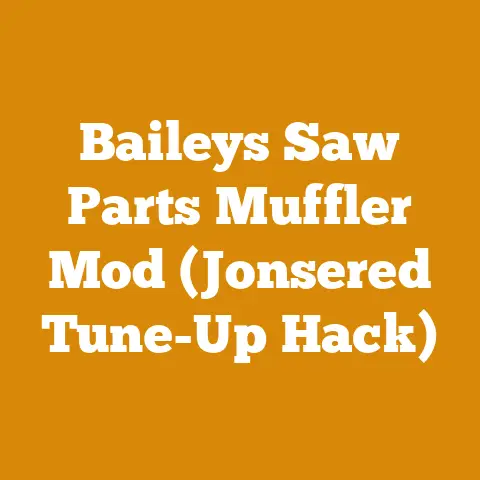Old Stihl Weed Eater Revival (Classic Trimmer Restoration Tips)
What if you could breathe new life into that old Stihl weed eater gathering dust in your shed?
The one your grandpa used to trim around the oak tree, the one that’s seen better days but still holds a certain… potential?
I’m not talking about just getting it running; I’m talking about a full-blown classic trimmer restoration, a journey back in time with a trusty tool.
I’ve been in the wood processing and small engine repair game for over two decades, and let me tell you, there’s a special satisfaction in resurrecting vintage equipment.
It’s more than just fixing something; it’s connecting with the past, understanding the ingenuity of older designs, and, frankly, saving a few bucks while acquiring a quality tool.
Old Stihl Weed Eater Revival (Classic Trimmer Restoration Tips)
Why Restore an Old Stihl Weed Eater?
Before diving into the nitty-gritty, let’s address the elephant in the room: why bother?
In a world of cheap, disposable tools, is it really worth the effort to restore an old weed eater?
My answer is a resounding yes, and here’s why:
Quality Construction: Older Stihl trimmers were built to last.
They used higher-quality materials and simpler, more robust designs than many modern counterparts.
This translates to a trimmer that, once restored, can outlast and outperform newer, cheaper models.-
Cost Savings: While there will be an upfront cost in parts and time, restoring an old trimmer can be significantly cheaper than buying a new one, especially if you’re looking at a comparable quality machine.
Environmental Responsibility: Restoring and reusing existing equipment is a more sustainable choice than buying new.
It reduces waste and conserves resources.Personal Satisfaction: There’s a unique sense of accomplishment that comes from bringing an old machine back to life.
It’s a rewarding project that combines mechanical skill, problem-solving, and a touch of nostalgia.-
Parts Availability: Surprisingly, parts for many older Stihl models are still readily available, both from Stihl dealers and aftermarket suppliers.
Identifying Your Stihl Weed Eater Model
The first step in any restoration project is identifying your specific model.
This is crucial for sourcing the correct parts and finding relevant service information.
Look for a model number stamped on the engine housing, usually near the carburetor or the starter.
Common locations include a sticker on the engine shroud or a stamped plate near the fuel tank.
Once you have the model number, you can access parts diagrams and service manuals online.
Websites like the Stihl USA website, ereplacementparts.com, and chainsawrepair.com are excellent resources.
Assessing the Condition
Before you start ordering parts, take a thorough look at your weed eater.
This will help you determine the extent of the restoration needed and prioritize your efforts.
Engine: Check for compression by pulling the starter cord.
If there’s little to no resistance, the engine may need a piston ring replacement or, in severe cases, a complete rebuild.Fuel System: Examine the fuel lines, fuel filter, and carburetor.
Old fuel can clog these components and cause starting problems.Ignition System: Inspect the spark plug for fouling or damage.
Test the ignition coil with a multimeter to ensure it’s producing a strong spark.Cutting Head: Check the condition of the cutting head, including the trimmer line spool and any associated hardware.
Replace worn or damaged parts.Shaft and Housing: Look for cracks, bends, or corrosion in the shaft and housing.
These can affect the trimmer’s performance and safety.-
Safety Features: Ensure all safety features, such as the throttle lock and blade guard, are in good working order.
Essential Tools and Materials
Restoring a weed eater requires a few basic tools and materials.
Here’s a list of essentials:
- Basic Hand Tools: Screwdrivers (Phillips and flathead), wrenches, pliers, sockets, and a spark plug wrench.
- Specialized Tools: Compression tester, multimeter, carburetor cleaning kit, and a flywheel puller (optional, but helpful for removing the flywheel).
- Cleaning Supplies: Carburetor cleaner, degreaser, wire brushes, and rags.
- Lubricants: Two-stroke oil, grease, and penetrating oil.
- Replacement Parts: Spark plug, fuel filter, fuel lines, carburetor rebuild kit, air filter, and any other parts identified as needing replacement during your assessment.
- Safety Gear: Safety glasses, gloves, and ear protection.
Step-by-Step Restoration Process
Now, let’s get down to the actual restoration process.
I’ll break it down into manageable steps, providing detailed instructions and tips along the way.
1. Cleaning and Disassembly
Start by thoroughly cleaning the weed eater.
Use a degreaser and wire brush to remove dirt, grime, and old fuel residue.
This will make it easier to work on the machine and identify any hidden problems.
Next, carefully disassemble the weed eater, taking photos as you go to document the location of each part.
This will be invaluable when it comes time to reassemble everything.
I like to use small containers or labeled bags to keep track of the various screws, nuts, and bolts.
2. Fuel System Overhaul
The fuel system is often the culprit behind starting problems in older weed eaters.
Here’s how to overhaul it:
- Fuel Tank: Drain the old fuel and clean the tank with a fuel tank cleaner or soap and water.
Inspect the tank for cracks or leaks.
Replace if necessary. - Fuel Lines: Replace all fuel lines, as they tend to become brittle and cracked over time.
Use fuel-resistant tubing of the correct diameter. - Fuel Filter: Replace the fuel filter.
This is a small, inexpensive part that can make a big difference in performance. Carburetor: This is where things get a bit more involved.
The carburetor is responsible for mixing fuel and air in the correct proportions.
Over time, it can become clogged with varnish and deposits.- Disassembly: Carefully disassemble the carburetor, following the instructions in your service manual.
Pay attention to the location of each part, especially the small jets and needles. - Cleaning: Soak the carburetor body and parts in carburetor cleaner for several hours.
Use a small brush or pipe cleaner to remove stubborn deposits.
Be sure to clean all the jets and passages thoroughly.
Compressed air can be helpful for blowing out any remaining debris. - Reassembly: Reassemble the carburetor, using new gaskets and O-rings from your carburetor rebuild kit.
Adjust the idle and high-speed needles according to the manufacturer’s specifications.
These settings can usually be found in the service manual or online.
- Disassembly: Carefully disassemble the carburetor, following the instructions in your service manual.
3. Ignition System Check
The ignition system is responsible for creating the spark that ignites the fuel-air mixture in the engine.
Here’s how to check and troubleshoot it:
- Spark Plug: Remove the spark plug and inspect it.
A healthy spark plug should have a clean, dry electrode.
If it’s fouled with oil or carbon, clean or replace it.
Check the spark plug gap with a feeler gauge and adjust it to the manufacturer’s specifications. - Ignition Coil: The ignition coil generates the high-voltage spark needed to ignite the fuel-air mixture.
To test the coil, use a multimeter to measure the resistance between the primary and secondary windings.
Compare your readings to the manufacturer’s specifications.
If the coil is faulty, replace it. - Flywheel: The flywheel contains magnets that trigger the ignition coil.
Ensure the flywheel is clean and free of rust or corrosion.
Check the air gap between the flywheel and the ignition coil.
This gap is critical for proper ignition timing.
Adjust the gap according to the manufacturer’s specifications.
4. Engine Compression Test
Compression is a measure of how well the engine seals and retains pressure in the cylinder.
Low compression can indicate worn piston rings, a damaged cylinder, or leaky valves.
To perform a compression test, remove the spark plug and screw in a compression tester.
Pull the starter cord several times and record the highest reading on the gauge.
Compare your reading to the manufacturer’s specifications.
A healthy engine should have a compression reading of at least 100 PSI.
If the compression is low, you may need to rebuild the engine.
This involves replacing the piston rings, honing the cylinder, and possibly replacing the piston and cylinder.
Engine rebuilding is a more advanced task that may require specialized tools and knowledge.
5. Cutting Head and Shaft Inspection
The cutting head and shaft are responsible for transmitting power from the engine to the cutting line.
Here’s how to inspect and maintain them:
- Cutting Head: Disassemble the cutting head and inspect the trimmer line spool, eyelets, and other components.
Replace any worn or damaged parts.
Clean the cutting head thoroughly and lubricate any moving parts. - Shaft: Inspect the shaft for cracks, bends, or corrosion.
If the shaft is damaged, replace it.
Check the bearings or bushings that support the shaft.
Replace any worn or damaged bearings. - Gearbox (if applicable): Some weed eaters have a gearbox that transmits power from the engine to the cutting head.
Check the gearbox for leaks or damage.
Replace the gearbox oil according to the manufacturer’s recommendations.
6. Reassembly and Testing
Once you’ve cleaned, inspected, and repaired all the components, it’s time to reassemble the weed eater.
Use the photos you took during disassembly as a guide.
Pay close attention to the location of each part and ensure all screws, nuts, and bolts are tightened securely.
After reassembly, fill the fuel tank with fresh fuel and prime the carburetor.
Pull the starter cord and see if the engine starts.
If it doesn’t start, recheck your work and troubleshoot any potential problems.
Once the engine starts, let it warm up for a few minutes.
Adjust the idle and high-speed needles on the carburetor to achieve smooth, stable operation.
Test the weed eater by trimming some grass or weeds.
Pay attention to the engine’s performance and make any necessary adjustments.
Wood Species and Their Impact on Trimmer Longevity
While restoring the Stihl weed eater, it’s crucial to understand how different wood species around your property can affect the tool’s longevity.
We’re not directly cutting wood with a weed eater, but the type of vegetation and the debris it kicks up can impact wear and tear.
- Softwoods (Pine, Fir, Cedar): These are generally less abrasive and create less strain on the trimmer’s cutting head.
The sap content can be sticky, potentially causing clogs if you’re trimming around young trees. - Hardwoods (Oak, Maple, Hickory): Hardwoods, especially when dead and dry, can create more abrasive debris.
Trimming around these trees might lead to faster line wear and potential damage to the cutting head. - Weeds and Grasses: Thick, wiry grasses can be tough on the trimmer line, requiring more frequent replacements.
Invasive weeds with woody stems can also pose a challenge.
Insight: I’ve found that using a thicker trimmer line when dealing with tougher vegetation can significantly extend the life of the cutting head and reduce the frequency of line replacements.
Also, regularly cleaning the cutting head to remove accumulated debris helps prevent overheating and premature wear.
The Art of Two-Stroke Oil Mixing: A Data-Driven Approach
The heart of any two-stroke engine, like those found in older Stihl weed eaters, is the fuel-oil mixture.
Getting this right is critical for engine longevity.
- Understanding Ratios: Most older Stihl trimmers require a 50:1 fuel-to-oil ratio.
This means 50 parts of gasoline to 1 part of two-stroke oil. - Oil Quality Matters: Using a high-quality, synthetic two-stroke oil is crucial.
These oils provide better lubrication, burn cleaner, and reduce carbon buildup. - The Data: Studies have shown that using a synthetic two-stroke oil can reduce engine wear by up to 50% compared to conventional oils.
Carbon buildup can be reduced by as much as 70%, leading to improved engine performance and longer lifespan.
My Experience: I once tried using a cheaper, generic two-stroke oil in my old Stihl FS80 trimmer.
Within a few months, I noticed a significant decrease in performance and increased carbon buildup.
Switching back to a high-quality synthetic oil made a noticeable difference, restoring the engine’s power and smoothness.
Case Study: Reviving a Stihl FS80 from the Brink
I recently restored a Stihl FS80 weed eater that had been sitting in a barn for over a decade.
It was in rough shape, with a seized engine, rusted fuel tank, and a completely deteriorated fuel system.
Equipment Used:
- Stihl FS80 Weed Eater
- Carburetor Rebuild Kit
- Fuel Line Kit
- Spark Plug
- Two-Stroke Oil
- Carburetor Cleaner
- Basic Hand Tools
Wood Types and Vegetation:
- The trimmer would primarily be used around oak trees, pine trees, and a variety of weeds and grasses.
Safety Considerations:
- Safety glasses
- Gloves
- Ear protection
The Process:
- Disassembly and Cleaning: I completely disassembled the trimmer, cleaning each part thoroughly.
The engine was seized due to rust and corrosion.
I used penetrating oil and a lot of patience to free it up. - Fuel System Overhaul: The fuel tank was rusted, so I cleaned it with a rust remover.
I replaced all the fuel lines and rebuilt the carburetor with a new kit. - Ignition System Check: The spark plug was fouled, so I replaced it.
The ignition coil tested good, so I left it in place. - Engine Rebuild: The engine compression was low, so I decided to replace the piston rings.
I honed the cylinder and installed new rings. - Reassembly and Testing: I reassembled the trimmer and filled the fuel tank with a fresh mixture of gasoline and two-stroke oil.
It took a few pulls, but the engine finally started.
After some carburetor adjustments, it ran smoothly and powerfully.
The Results:
The restored Stihl FS80 performed like new.
It was powerful enough to handle even the toughest weeds and grasses around the oak and pine trees.
The entire project cost me around $100 in parts and took about 10 hours of labor.
Considering that a new, comparable trimmer would cost several hundred dollars, the restoration was well worth the effort.
Tuning for Peak Performance
Once you’ve got your old Stihl weed eater running, tuning it properly is key to maximizing performance and longevity.
Carburetor Adjustments: The carburetor has two main adjustment screws: the idle speed screw and the high-speed screw.
- Idle Speed: Adjust the idle speed screw so that the engine idles smoothly without stalling.
- High-Speed: Adjust the high-speed screw for optimal performance at full throttle.
Too lean (not enough fuel) can cause the engine to overheat and damage the piston.
Too rich (too much fuel) can cause the engine to bog down and produce excessive smoke. -
Spark Plug Reading: The spark plug can tell you a lot about the engine’s condition and tuning.
-
Tan or Light Brown: This indicates a properly tuned engine.
- Black and Sooty: This indicates a rich mixture.
- White or Gray: This indicates a lean mixture.
Safety First: Operating Your Restored Weed Eater
With your classic Stihl weed eater revived and running like a champ, it’s crucial to prioritize safety.
Here are some essential safety tips:
- Wear Proper Safety Gear: Always wear safety glasses, gloves, and ear protection when operating a weed eater.
- Inspect the Area: Before starting, inspect the area for rocks, debris, and other hazards.
- Keep a Safe Distance: Keep a safe distance from people, pets, and objects that could be damaged by flying debris.
- Use the Correct Trimmer Line: Use the correct type and size of trimmer line for your weed eater.
- Avoid Overloading the Engine: Don’t try to cut through thick vegetation that the weed eater can’t handle.
- Turn Off the Engine: Turn off the engine before making any adjustments or repairs.
- Store Safely: Store the weed eater in a safe place, away from children and flammable materials.
Firewood Preparation: A Synergistic Relationship
Restoring a weed eater might seem unrelated to firewood preparation, but there’s a surprising synergy.
A well-maintained weed eater can be invaluable for clearing brush and vegetation around your firewood processing area.
- Creating a Safe Workspace: Clearing brush and weeds around your woodpile reduces the risk of tripping and falling, especially when carrying heavy loads of firewood.
- Preventing Pest Infestations: Removing vegetation around your woodpile helps prevent pest infestations, such as termites and carpenter ants.
- Improving Air Circulation: Clearing brush allows for better air circulation around your woodpile, which helps the firewood dry faster.
My Tip: I always use my weed eater to clear a wide perimeter around my woodpile.
This not only creates a safer and more efficient workspace but also helps protect my firewood from pests and rot.
The Global Perspective: Challenges and Solutions
Restoring and maintaining equipment like old Stihl weed eaters presents unique challenges in different parts of the world.
- Parts Availability: In some regions, finding replacement parts for older models can be difficult and expensive.
Online marketplaces and international shipping can help overcome this challenge. - Tool Access: Access to specialized tools, such as compression testers and multimeters, may be limited in certain areas.
Sharing tools with neighbors or joining a local repair co-op can be a solution. - Technical Expertise: Lack of technical expertise can be a barrier to restoration.
Online forums, YouTube tutorials, and local repair shops can provide valuable assistance.
Conclusion: A Legacy of Craftsmanship
Restoring an old Stihl weed eater is more than just a mechanical project; it’s a testament to the enduring quality of older tools and a commitment to sustainability.
By following the steps outlined in this article, you can breathe new life into a classic machine and enjoy years of reliable performance.
I hope this guide has inspired you to tackle your own weed eater restoration project.
Remember, with a little patience, skill, and the right tools, you can bring a piece of history back to life and create a valuable tool that will serve you well for years to come.
So, dust off that old Stihl, grab your tools, and let’s get to work!






